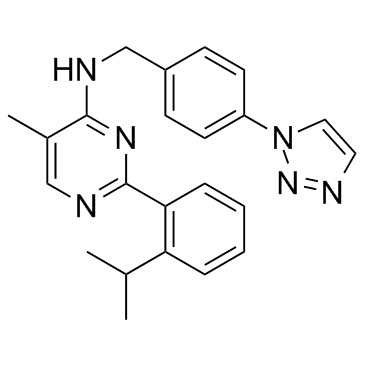1572414-83-5
| Name | 4-Pyrimidinamine, 5-methyl-2-[2-(1-methylethyl)phenyl]-N-[[4-(1H-1,2,3-triazol-1-yl)phenyl]methyl]- |
|---|---|
| Synonyms |
N-(4-(1H-1,2,3-triazol-1-yl)benzyl)-2-(2-isopropylphenyl)-5-methylpyrimidin-4-amine
2-(2-Isopropylphenyl)-5-methyl-N-[4-(1H-1,2,3-triazol-1-yl)benzyl]-4-pyrimidinamine 4-Pyrimidinamine, 5-methyl-2-[2-(1-methylethyl)phenyl]-N-[[4-(1H-1,2,3-triazol-1-yl)phenyl]methyl]- ML-323 |
| Description | ML-323 is a reversible, potent USP1-UAF1 inhibitor with IC50 of 76 nM in a Ub-Rho assay. The measured inhibition constants of ML-323 for the free enzyme (Ki) is 68 nM. |
|---|---|
| Related Catalog | |
| Target |
IC50: 76 nM (USP1-UAF1, in Ub-Rho assay)[1] Ki: 68 nM (USP1-UAF1)[1] |
| In Vitro | ML-323 (ML323) is a highly potent inhibitor of the USP1-UAF1 deubiquitinase complex with excellent selectivity against human DUBs, deSUMOylase, deneddylase and unrelated proteases. ML-323 is a potent USP1-UAF1 inhibitor with IC50 values of 76 nM in a ubiquitin-rhodamine (Ub-Rho) assay and 174 nM and 820 nM in orthogonal gel-based assays using K63-linked diubiquitin (di-Ub) and monoubiquitinated PCNA (Ub-PCNA) as substrates, respectively. ML-323 probably exerts its inhibitory effect through an allosteric mechanism. The measured inhibition constants of ML-323 for the free enzyme (Ki) and the enzyme-substrate complex (K’i) are 68 nM and 183 nM. Besides, ML-323 potentiates Cisplatin cytotoxicity in non-small cell lung cancer and osteosarcoma cells[1]. ML-323 (ML323), a probe molecule that displays reversible, nanomolar inhibitory activity and excellent selectivity toward USP1/UAF1. In addition, ML-323 potentiates the cytotoxicity of Cisplatin and increases endogenous monoubiquitination levels of both PCNA and FANCD2, two known cellular targets of USP1/UAF1[2]. |
| Kinase Assay | For DUB profiling, ML-323 is tested at a single-dose of 10 μM in duplicate. The DUB activities are monitored using Ub-7-amido-4-methylcoumarin (AMC) as a substrate. The increase in fluorescent signal from free AMC is monitored over time, although only the initial linear portion of slope (signal/min) is used for analysis. The activity of enzyme with no compound is treated as 100%. For protease profiling, ML-323 is tested using threefold serial dilutions starting at 20 μM against 70 proteases. Proteases are pre-incubated with the compound for 5-15 min before the addition of the appropriate enzyme substrates. The enzyme activities are measured by reading the fluorescent signal from fluorescently labeled peptides[1]. |
| Cell Assay | Cell viability is measured by a cell counting kit (CCK) assay using CCK-8 solution. For the colony-forming assay, cells are seeded at a density of 300-500 cells per well in six-well plates and grown overnight. Cells are then treated with ML-323 alone, Cisplatin alone or a combination of Cisplatin and ML-323 (1:1 or 1:4) at the indicated concentrations. Cells treated with an equal volume of DMSO and saline are used as a control. After 48 h of treatment, fresh growth medium is added, and cells are incubated for an additional 5-10 d to allow for colony formation. For UV combination treatment, the cells are treated with ML-323 at the indicated concentrations or an equal volume of DMSO. After 48 h, the medium is removed, and cells are irradiated at 254 nm at the indicated dosage. Fresh growth medium is added, and the cells are incubated for an additional 5-10 d to allow for colony formation. The cells without UV irradiation but treated with ML-323 or an equal volume of DMSO are used as controls and designated as 100%. After the formation of the colonies, cells are fixed with methanol and stained with 0.5% crystal violet. Colonies consisting of >50 cells are scored. The number of colonies is determined from triplicate plates. The dose-response curves are generated using GraphPad Prism and analyzed by using CalcuSyn to calculate the combination index, which is determined for the fraction of cells affected after the addition of fixed ratios of cisplatin and the USP1-UAF1 inhibitor[1]. |
| References |
| Density | 1.2±0.1 g/cm3 |
|---|---|
| Boiling Point | 515.4±60.0 °C at 760 mmHg |
| Molecular Formula | C23H24N6 |
| Molecular Weight | 384.477 |
| Flash Point | 265.5±32.9 °C |
| Exact Mass | 384.206238 |
| PSA | 68.52000 |
| LogP | 4.61 |
| Vapour Pressure | 0.0±1.3 mmHg at 25°C |
| Index of Refraction | 1.651 |
| Storage condition | 2-8°C |
| Symbol |

GHS07 |
|---|---|
| Signal Word | Warning |
| Hazard Statements | H315-H319-H335 |
| Precautionary Statements | P261-P305 + P351 + P338 |
| RIDADR | NONH for all modes of transport |
